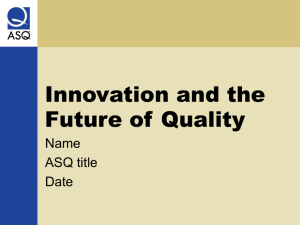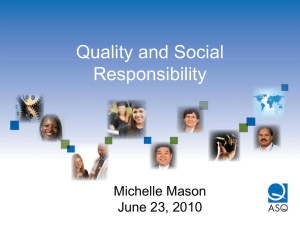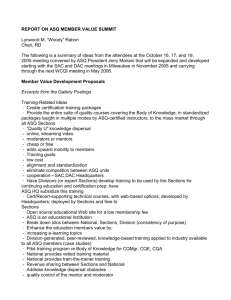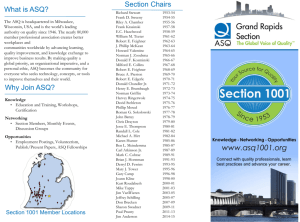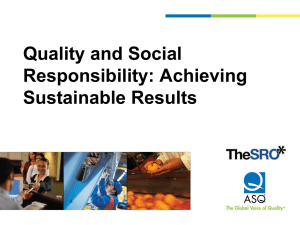Recent Advances and Future Directions for Quality Engineering
advertisement
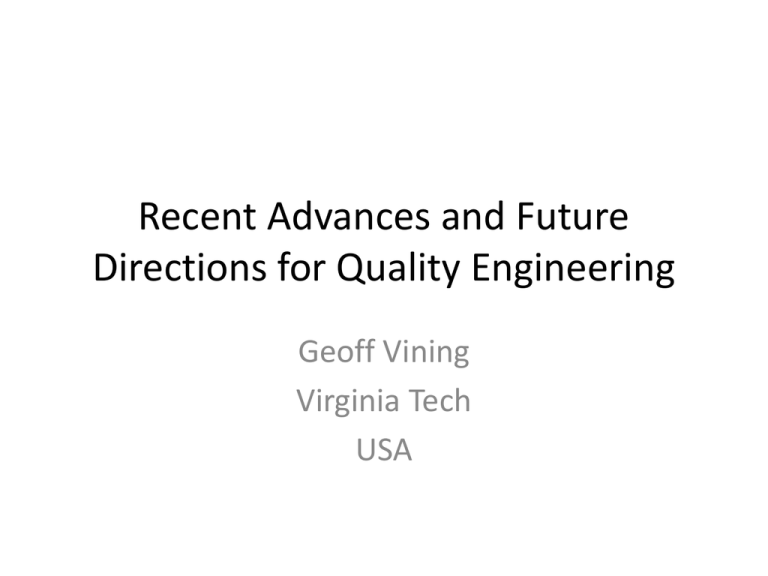
Recent Advances and Future Directions for Quality Engineering Geoff Vining Virginia Tech USA Outline • Recent Advances – Extending Standard Methodologies to Hard, Practical Problems – “Statistical Thinking” – Applications in Areas Other than Manufacturing – Advances in Software (However, Need Caution) – Truly Global Reach Outline • Future Directions – Integrating Quality Engineering Concepts over Complex Systems – Large Data Sets – Dealing with Image Data – Greater Emphasis on Reliability – Innovation – Strong Need to Train Practitioners Properly (Dangers of Current Software!) • Statistical Engineering Background • Past Department Head of Statistics at Virginia Tech • Past Editor of the Journal of Quality Technology (1998-2000) • Past Editor of Quality Engineering (2009-2010) • Past Chair of the ASQ Publications Management Board • Member of the ASQ Board of Directors Background - Journals • Quality Engineering – Co-Published by ASQ and Taylor & Francis – Practitioner Focus • Journal of Quality Technology – Published by ASQ – Focus on High Level Practitioner/Academic Background - Journals • Technometrics – Co-Published by ASQ and ASA – Similar Focus as JQT, Tends to be More Mathematical • Quality and Reliability Engineering International – Published by Wiley – More European – Publishes “Best” Papers from ENBIS Extending Standard Methodologies to Hard Problems • Experiments with Hard-to-Change and Easyto-Change Factors – Very Common Practical Problem – Extensive Literature for Agricultural Applications – Jones and Nachtsheim • Profile Monitoring – Characteristic of Interest Is a Profile (Function) – Woodall • Computer Experiments “Statistical Thinking” • Originated in the mid 90s • Basic Idea: – All work occurs in a system of interconnected processes. – Variation exists in all processes. – The keys to success are: • understanding variation • reducing variation. “Statistical Thinking” • Roger Hoerl and Ron Snee (2012) Statistical Thinking: Improving Business Performance (Wiley and SAS Business Series) • Point: Biggest contribution that quality practitioners can make: get senior managers to understand variation and its sources • Data Analysis in North America is easy to send off-shore! Applications in Areas Other than Manufacturing • See Quality Engineering for Examples • Service Functions – Accounts Payable – Product Delivery – Costumer Relations • • • • Risk Management Security Healthcare Several People in Israel Have Done Very Nice Work! Advances in Software • Current Software Can Do Much More Sophisticated Statistical Analyses to Support Quality Engineering – Hard-to-Change versus Easy-to-Change Factors – Integrated Variance Optimal Designs – Space-Filling Designs (Computer Experiments) – Gaussian Stochastic Processes (Comp. Exp.) Advances in Software • Exercise Caution with Software “Claims”! • You Do Not Need to Think about Data Collection – Give Us the Factors and the Levels – We Give You the Plan • You Do Not Need to Think about The Analysis – We Plan the Data Collection – We Know the Best Analysis • Consequence: Potential for Major Disasters! Advances in Software • Software Is an Extremely Important Tool – Requires Intelligent Use – “Fisher in a Box”/”George Box in a Box” Does Not Exist! • Data Collection Requires Intelligent Collaboration – Ask the Right Questions – Think Carefully about the Science – Translate Everything Properly into the Analysis Global Reach • Foundations to Quality Engineering are North American and Japanese Manufacturing – North America: Statistical Theory and Methods – Japan: • Quality Management • “Soft Tools” • Teamwork – Deming, Box, Taguchi, “The Gurus” Global Reach • Important Influences – Movement of Manufacturing Away from North America • • • • Asian Tigers China India Latin America (Brazil and Mexico) – Recognition in Europe of Need for Quality Engineering: ENBIS Impact of Global Reach • Editorial Boards Are Truly Global • Authors Publishing in the Quality Engineering Journals Are Truly Global • Proliferation of Outstanding Quality Engineering Conferences • ASQ - Global Future Directions • Current Directions Will Continue to Grow • New Directions – “Research” – “Practice” – Be Aware of the Divide! Integrating Quality Engineering Concepts Across Complex Processes • Complex Processes as Opposed to “Data Mining” (Next Topic!) – Developmental Testing of Weapon Systems • • • • Multiyear Multistage Different Objectives at Each Stage Competing Interests! – Complex Manufacturing Processes • Multistage • Often, Multi-location Integrating Quality Engineering Concepts Across Complex Processes • Good Quality Engineering Practices May or May Not Being Used at Substages • In Some Cases, Just Applying Current Quality Engineering Methods to the System Work • In Many More Cases, Need New Methodology – Formal/Informal Bayesian Methods – Belief Networks Large Data Sets • Data Mining Is Becoming Extremely Important • Great Deal of Good Work in Israel! • Emergence of Massive Data Warehouses (Planet Scale!) • Standard Statistical Approaches – Not Valid – Not Informative • Often Most Interesting Phenomena: Outliers! Image Data • Ability to Monitor Processes via Image Data • Basic Analysis of Image Data Becoming “Mature” • In Some Cases, May Be Able to Adapt Standard Statistical Process Control Techniques • In Many Cases, Must Create New Monitoring Procedures Based on Image of Every Item Greater Emphasis on Reliability • Reliability: Quality Over Time • Customers Beginning to Demand Highly Reliable Products and Processes • Simple Accelerated Life Tests Not Sufficient • Strong Need: – Experimental Design and Analysis for Reliabilty Data – Process Control with Reliability Data Innovation • Not Long Ago, Building Better Quality Was Significant Innovation • High Quality Now Viewed as Expectation • New Issue: Next Way to “Delight” Customers – “Improved” Current Products – New Products Customers Never Imagined • Issue: How Can Quality Engineering Facilitate Innovation • See January 2012 Issue of Quality Engineering Proper Training of Practitioners • Six Sigma Brought Quality Engineering into the Hands of Subject Matter Experts – Typical Training Barely Scratched Surface – “3 Month Wonders” – Often, Do Not Know When to Call an Expert • Software Developments • Proper Follow-Up Training Essential Statistical Engineering • How to best use known statistical principles and tools to solve high impact problems for the benefit of humanity. – tactical integration of statistical thinking with the application of statistical methods and tools (at the operational level – drive proper application of statistical methods based on solid understanding of statistical thinking principles. – typically involves the appropriate selection and use of multiple statistical tools, integrated into a comprehensive approach to solving complex problems. • Focus on Large, Unstructured, Complex Problems • Most Recent Issue of Quality Engineering (April 2012)

